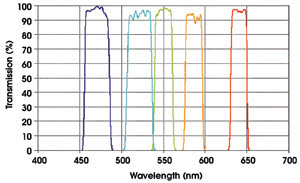Herman Chui, Bookham Inc.
Photonics technologies find application in many analytical instruments in the life sciences. In drug development, for example, photonics enables high-specificity, high-throughput screening for the identification of drug targets and for the genetic screening of subjects.
As drug-development costs continue to rise, greater emphasis is placed on the early stages to increase the success rate in later stages. Similarly, in medical diagnosis, photonics is enabling advances in the early clinical screening of such diseases as HIV, cardiovascular disorders and glaucoma. As these and other areas continue to expand, photonics for the life sciences also should continue to experience growth.
Optical filters, in particular, are a central element of these techniques and can be a determinant of accuracy and throughput. Life sciences analytical instruments increasingly are moving to a larger number of colors in multicolor measurement for improved instrument capability and performance, resulting in a greater need for optical filters for precision color separation.
For example, flow cytometry systems can detect 10 or more colors for the discrimination of a wider variety of cell types.1,2 Similarly, confocal and wide-field microscopes are using multichannel, multicolor imaging for the simultaneous observation of multiple species. Real-time polymerase chain reaction amplification systems also are shifting to multicolor detection and multiplexed measurements that offer increased throughput and signal normalization in gene-regulation studies.3
Optical filters used in the life sciences typically comprise multilayer coatings that enable wavelength-selective transmission and blocking based on optical interference in these layers. Traditionally, the performance of optical filters has been limited by the variation in individual layer thickness and composition and by the small number of layers that can be deposited. The increasing use of multicolor measurement is further raising the performance requirements for optical filters.
For example, to reduce crosstalk between closely spaced fluorescence emission spectra, greater blocking and sharper filter edges are required. Multicolor systems also typically cascade several filters in series, thereby requiring higher transmission per filter to maintain signal-to-noise performance. Finally, traditional optical filters have soft coatings that exhibit limited lifetime and reliability. In some environments, they can degrade and may require replacement in two to three years.
Recently, advances have been made in filter coating technology, driven largely by the demanding requirements of telecommunication applications. With a so-called advanced energetic deposition coating technology, many hundreds of layers can be deposited, each with an exceptional degree of precision, enabling the fabrication of filters with better performance. For example, fluorescence filters with greater than 90 percent transmission over the passband, better than OD 6 (i.e., 10–6 transmission) blocking over the stopband and very steep filter edges can be manufactured (see figure). These enhancements translate into significantly improved contrast, or signal-to-noise ratio.

Filters produced using an advanced energetic deposition process exhibit greater than 90 percent transmission over the passband and better than OD 6 blocking over the stopband. (Results from New Focus, a division of Bookham Inc.)
This coating technology relies on a highly energetic deposition process that produces very dense coatings, improving the reliability as well as the heat and moisture resistance of these filters. After extended exposure to high temperature (85 °C) and high humidity (85 percent relative humidity), filters manufactured using the process exhibit negligible change in performance. Such filters produced for telecommunications have exhibited zero failures in more than 1 billion hours in the field.
These advancements in filter performance and reliability yield significant improvements in the capability and performance of analytical instruments. The improved contrast enables high throughput in analytical and diagnostic instrumentation, resulting in faster screening, or analysis, turnaround time and increased instrument capacity.
With multicolor measurement systems, these advancements also improve discrimination in multicolor analytical instruments and reduce signal crosstalk. For example, newer flow cytometers can measure and sort more than 20,000 cells per second, up from fewer than 10,000 cells per second, while simultaneously detecting many emission and laser scattering signals.
By further increasing signal-to-noise ratio with these new filters, even higher throughput and multicolor discrimination may be achievable. Similar improvements may be expected in other applications, from DNA sequencing to microscopy for live-cell imaging.
References
1. M. Roederer et al (Dec. 1, 1997). 8 Color, 10-parameter flow cytometry to elucidate complex leukocyte heterogeneity. CYTOMETRY, pp. 328-339.
2. S.C. De Rosa and M. Roederer (December 2001). Eleven-color flow cytometry. A powerful tool for elucidation of the complex immune system. CLIN. LAB. MED., pp. 697-712.
3. S. Tyagi et al (January 1998). Multicolor molecular beacons for allele discrimination. NAT. BIOTECHNOL., pp. 49-53.
Meet the author
Herman Chui is director of product marketing at New Focus, a division of Bookham Inc. in San Jose, Calif.; e-mail: [email protected].